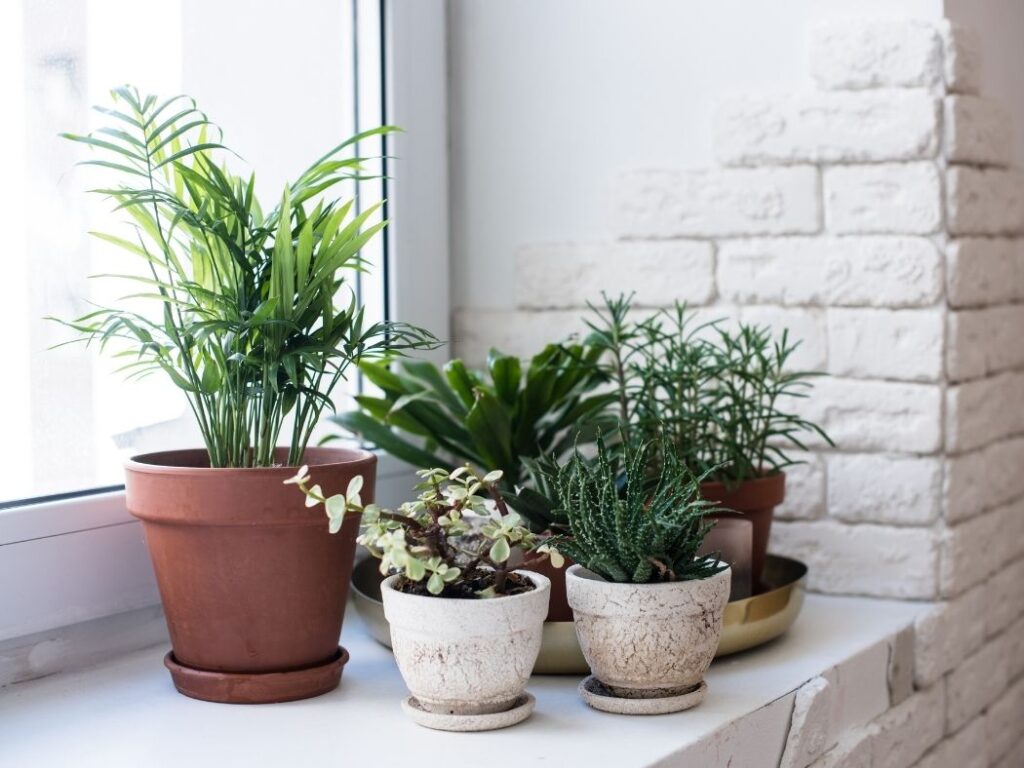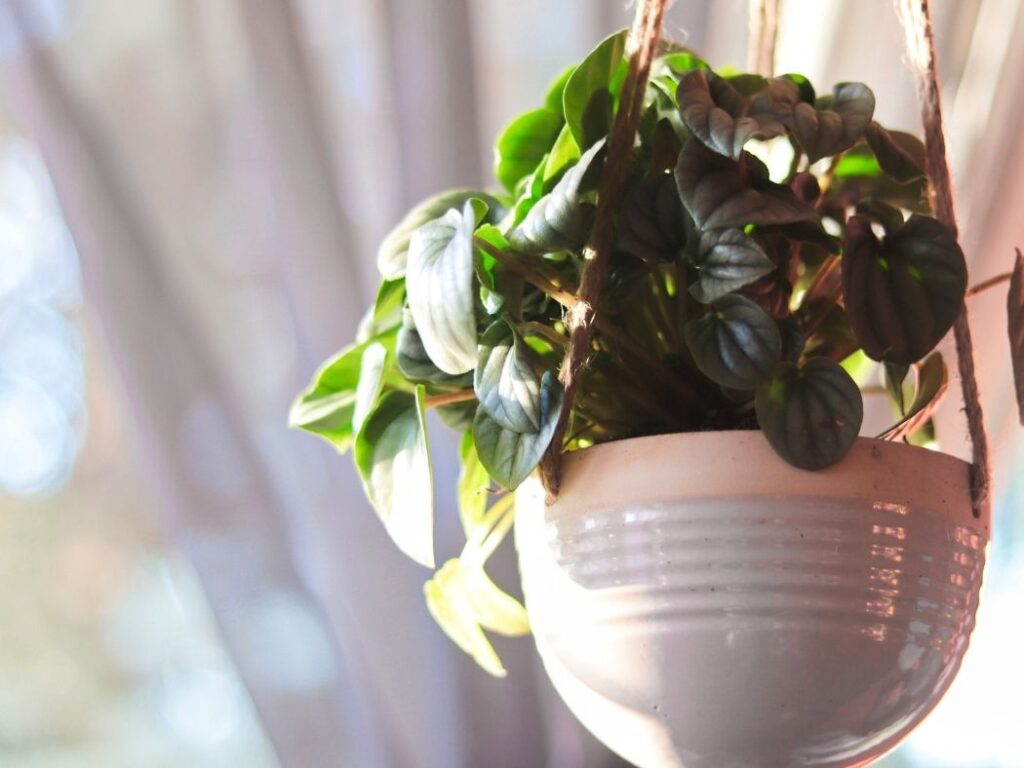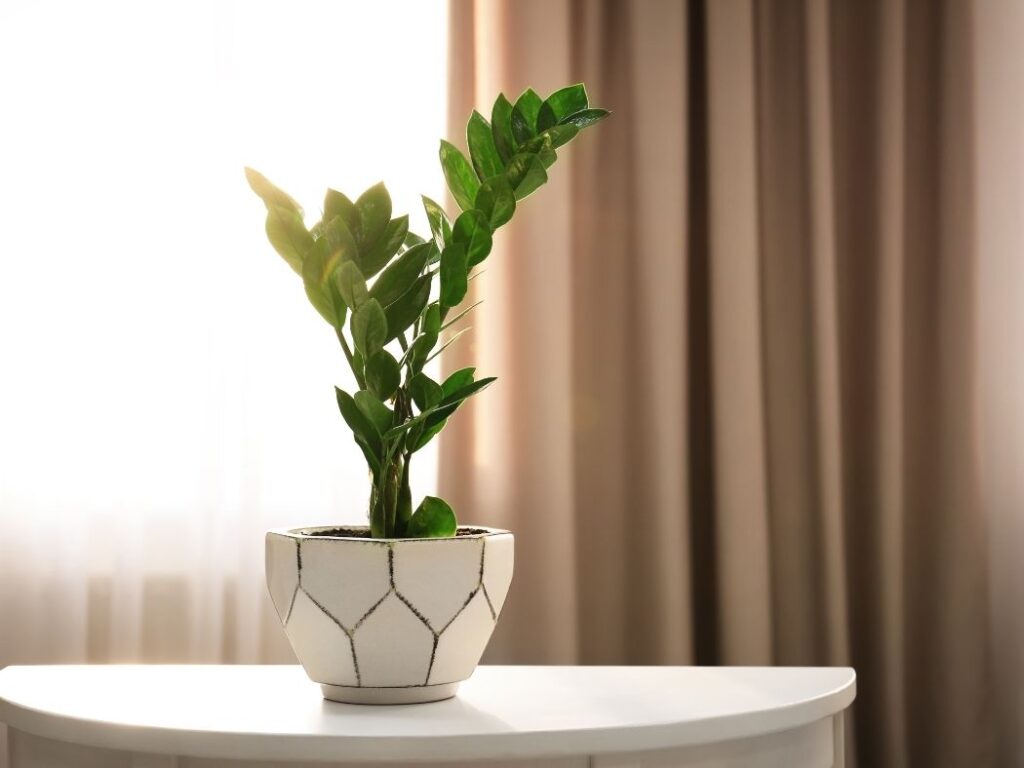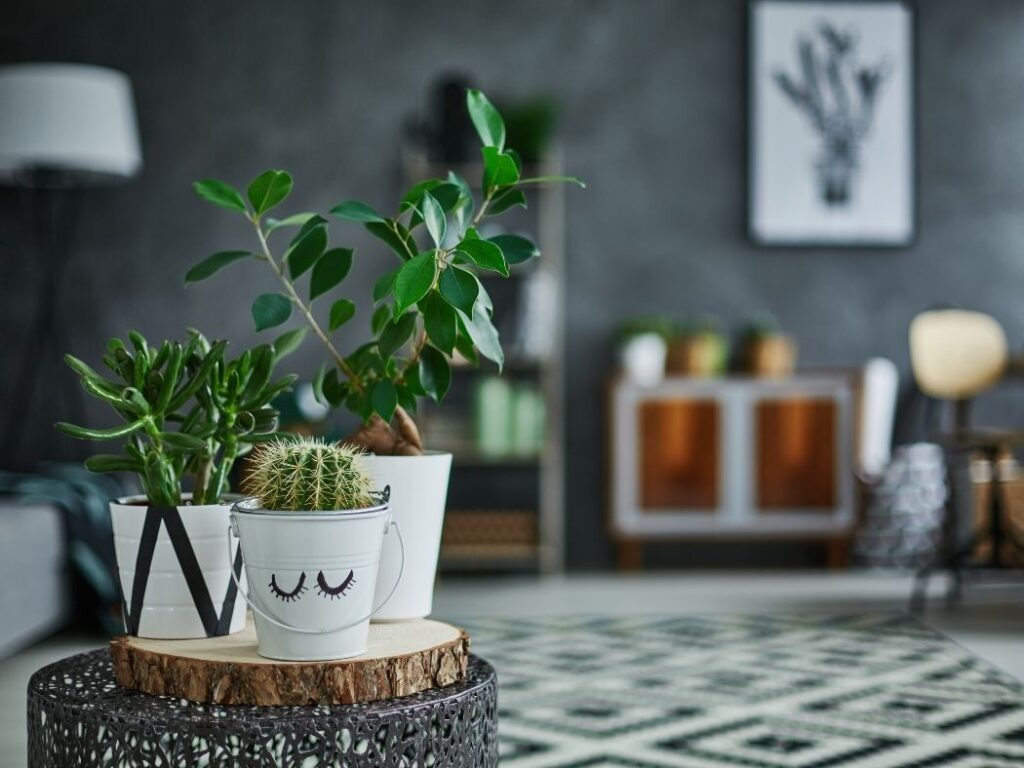There are many benefits to decorating with plants, including the purely aesthetic values that plants can add to any room as well as the air purification qualities that houseplants bring. Plus, there is something wonderful about surrounding yourself with living, breathing home decor.
Being able to care for and grow your own home decor is a very rewarding thing, although the flip side (when or if a houseplant dies) can be more traumatizing than one would expect. For many years, I have accented the various rooms in my home with houseplants, and I love the way that decorating with plants can add an ever-growing and natural splash to a room.
They are also great on those cold winter days when everything outside looks bleak and barren.
Plants are not the easiest piece of decor that you can add to your home. After all, you have to take into consideration the care and maintenance that will be required, how much light the plant will need to thrive, and how often it will need to be watered.
However, if you pick the right plants in the right places, they can make for a lovely, unique, and ever-growing part of your home’s overall landscape (pun intended).
What is plant decorating?
Plant decorating is not a new trend, it has been around for years. Many decorators even offer classes on how to properly plant your plants in an attractive way. An even bigger benefit is that plants are inexpensive. Plant material can be purchased in bulk for less than one would spend on one medium-priced decorative piece. When combined with the natural beauty of your choice of flower or foliage, it is a very attractive approach. How to decorate with plants First, you will need to decide what color plants you want to use.
Why decorate with plants?
It is pretty easy to see the effects that living plants can have on your home’s decor when we compare them to inanimate objects. Not only can they be used to reflect our personal style when decorating because of the wide variety not only in the plants themselves but also when it comes to the things that we choose to put in them.
Some of the other benefits of living plants as decorating is that they provide a bit more of an organic feeling to the home that comes from the plant itself, creating a sense of breathability that is very difficult to achieve with other decor accents.
Plus, of course, the fact that living plants help remove toxins from the air that you breathe on a daily basis. That is especially so when you select varieties that are known for their purification capabilities. According to the American Academy of Family Physicians, most homes have a ratio of bacteria to air about 60:40. When it comes to allergy relief, those bacteria and airborne allergens need to be removed. Plant purifiers help to break down the toxins that are around your home and remove them from the air.
Whether your house is small or large, surrounding yourself with plants brings with it a feeling of comfort and relaxation. If you have an airy apartment with expansive windows and a high ceiling, giving the illusion of a higher ceiling, putting a plant in that space will add a cool dimension to your space.
A few plants placed throughout your home can add visual appeal, without taking up much space in the room. The scent and sight of a house plant brighten up a space and provide an attractive focal point.
Using Stand Alone or Statement Plants

There are many ways to decorate with plants, but one of the most common ways is to have one “statement” plant that is used to enhance the decor of a single room.
When it comes to adding a splash of color and life to a room, plants come in all shapes and sizes to help create a statement. Large, bold, potted plants can take up much of the available space in a room, yet still have the ability to add life. On the other hand, something as delicate as succulents can be planted in small places, while remaining beautiful. You can also find both types in the same plant!
Regardless of size or location, plant pots can be used for almost any decor – from minimalist designs to BoHo Chic. Just a few accessories and a few succulents can give your room a complete makeover.
A well-decorated room shouldn’t ever feel empty or bland. In fact, no matter what design style you are going for, a room should look inviting – if not cozy. Decorating with plants can help add a bit of natural decor to any room, bringing life to an otherwise barren room.
A key factor of any room is the focal point, which is where statement plants come in. These plants are often very large, very colorful, and very airy. Therefore a statement plant or two is important in any decor scheme.
Sometimes, less is more, which is why an all-white living room can be alluring and lovely if the furnishings and accessories in that room are all white. However, the same can be said for the other side of the spectrum, which is where a mix of bold and moody plants comes in. There are many different types of plants that can give off varying shades of blue and green, as well as bold fuchsia or orange.
Whether you add one plant as a statement or a contrast to your existing design or create an entire plant display is up to you!
Creating a Focal Point with Plant Collections

Have you ever noticed how adding one or two plants can completely transform a room? Sure, the space is still the same, but a few potted herbs, small potted trees or succulent plants that were previously just a part of your home’s interior now become an important focal point.
Adding a collection of small plants (such as orchids or philodendrons) can create a decorative focal point that is eye-catching and unique to your home.
This is also a great way to bringing the outdoors inside during the colder months of the year. Not only can you rescue outdoor plants that are not hardy enough to survive the winter, but you can also extend the beauty of those plants by letting them flourish indoors instead.
However, the transition between outdoors and indoors (and then back outdoors again) is not always successful. Although I’ve had no problems moving my spider plants indoors for the winter and then outdoors onto the back patio in the summer, I’ve had less success trying to keep my Hibiscus happy during those transitions.
Many people enjoy having plant collections but are sometimes unsure about where to start. Plant collections usually look beautiful in a particular color scheme, but it is also a good idea to try something different and include a splash of contrasting colors.
The great news with plant decorating is that nature works well with nature. It is very, very rare that two plants – of any kind – don’t somehow complement each other in a wonderful, unique, and natural way. The only thing you need to consider when decorating with plants is if the conditions they need to thrive are the same. If you put two plants in a low-light area, and one needs lots of sunshine, it will end up withering and will not be an attractive part of the overall display.
The other great news about decorating with plant collections is that you can move things around quickly and easily to change up the look and feel of the space within a few minutes. Want to go with a more serene look, switch out your plants. Want a pop of color to warm up winter, switch out your plants!
A great way to see what you like and want to grow is to look online at the many plant websites and magazines and try to narrow down what you would like. You may be surprised by what you find and how much you would love to grow, or how much a certain plant costs.
Also check with friends and family, as indoor plants are quite often easily propagated, so you can grow new plants by simply clipping a small piece of the old plant and rooting then planting it yourself in your own pots.
Creating Plant Displays

There is something so lovely about a shelf filled with plants. I especially like the contrast of industrial pipe shelves with living greenery. For some plants, it might be possible to simply place them directly on a shelf in a simple pot. For others, such as succulents, the perfect container is a cactus or aloe vera frame. Once it is placed on a shelf, small amounts of water and nutrients should be added to keep it thriving. And, of course, make sure that the shelf has the right amount of natural (or supplemented) light.
Although plants themselves will never go out of style, the containers can become a bit boring. Some people have taken to reusing their old pots, pitchers, planters, or hanging baskets as decorative containers. It’s a great way to take unique and used objects and turn them into a gorgeous houseplant display. But don’t overdo it, as much fun as decorating with plants can be… not every room needs a flower-filled altar or bonsai waterfall.
Creating themed plant-stuffed carts is another sure-fire way to turn your room into a green oasis. It’s a project that can take anywhere from two hours to a few hours, depending on the size of your home, your creativity, and your personal taste.
Not only are these displays quite lovely, but they are also easy to move (as they are often on wheels). Any kind of cart or buggy can be instantly transformed into a living piece of art by adding an abundance of plants. I’ve even seen some beautiful displays using old bicycles (both indoors and out).
Decorating with Hanging Plants

Houseplants can be hung, draped, or otherwise displayed in any number of ways, depending on the species, the size of the plant, and your own creativity.
The added level of fun, sophistication, or whimsy a hanging plant brings to a home can enhance any decor.
Hanging plants are usually one of the easiest to maintain living plants and can be found in almost any store. Whether you choose one of the more delicate petunia varieties, like the Ballet Flosses or the Far East Dragons, or go the no-frills route and go for the Hyacinthus or the Spider Plant, as these are both very hardy plants, they will still look amazing in your living room.
These hanging plants will add a little green to the room, which can brighten your day, and as mentioned, they will help with air purification, too!
For example, you can hang plants in window wells, above furniture, or fill an empty corner. The other great thing is that they can be created to match your decor. Macrame hanging plant holders are great to achieve that boho look, while steel chain and aluminum plant pots give off a decidedly industrial vibe. Whether you’re aiming for a contemporary or a farmhouse look, you can find just the right hanging planter to fit your style.
Always remember when you’re decorating with plants – especially hanging plants – that you need to be able to reach the plant for regular care and maintenance and that nothing beneath the plant can be damaged if the water should overflow (which happens, on a regular basis… at least to me).
Setting Up a Plant Terrarium

One of the latest methods for transforming your home into a living, breathing space is with terrariums. Available from plant stores, these glass and plant-lined plastic vessels hold plants, driftwood, glass ornaments, small mirrors, jewelry, and more.
This provides a unique opportunity to let your creativity out, as a plant terrarium is half living plants and half the other elements that you add to infuse your own personal style into the Terrarium.
To really take your plant obsession to the next level, try a larger, more room-dense option. An open terrarium allows you to create the illusion that the plants are living inside the interior of the terrarium itself. Keep your plants inside their enclosure or surround your terrarium with air plants (ferns and other small plants) to create the illusion of flowing water or mason jars filled with water for more visual depth.
Keep in mind that not every houseplant will thrive within a terrarium, but if your intent is to design a low-maintenance, living focal point in your home’s decor, succulents are often your best choice!
As always, when you’re decorating with plants – especially when it comes to terrariums – make sure that you combine plants that require the same amount of light and water because trying to provide different plants inside the same terrarium with different levels of light and water is almost impossible. However, if you do make a mistake, it’s easy to replace plants within your terrarium should something go wrong along the way.
Closed Terrariums are another approach. The main difference is that closed terrariums create their own water cycle, which makes them the perfect, low-maintenance addition to your home’s decor.
While Bottle Terrariums can be quite difficult to create based on the very nature of the bottle (aka a narrow opening to access to the inside), Apothecary or Mason Jars can make fun and easy to assemble closed plant terrariums.
Of course, although the way you’d build a closed terrarium is quite like creating an open terrarium, the plants will be very different. For example, Cacti and Succulents are not suitable plants for Closed Terrariums; instead, Tropical plants that thrive in humid conditions are usually the best options.
Decorating with Tropical Indoor Plants

By adding fresh & colorful tropical plants to your home, you will be adding a lot more life and spirit than you might think. And though you can buy all the houseplants you want (it’s rare that I see a home that has too many plants), it is nice to get some inspiration from other people who have taken on the challenge of putting living plants in their homes.
Need some ideas on the tropical plants to add to your home’s decorative landscape? Here are the 18 Best Tropical Plants for Indoor Decorating (in no particular order).
- Peace Lily – The Peace Lily is an extremely popular plant that does a wonderful job of creating a beautiful focal point in any room. It is a gorgeous, elegant, and easy-to-maintain plant.
- Rubber Tree – These amazing trees have been around for decades but remain as popular now as they have ever been – and for good reasons.
- Philodendron – Though these houseplants are tropical in their habits, you can use them in any type of home decorating style.
- Orchid – If you have a bit of a green thumb and are looking for a wonderful and showy plant to add to your home, an Orchid is the way to go.
- Dracaena – You can find a huge variety of dracaena that are truly perfect for any home decor. Dracaena are very easy to care for and do a great job of cleaning the air.
- Stromanthe Tricolor – This tropical plant adds a showy bit of color with its tricolor leaves in green, white, and vibrant red. A beautiful, fragrant hybrid tea tree, this plant has unique coloration that can match almost any decor style, from minimalist to bohemian.
- Ficus – There are many different kinds of Ficus trees, but the type that is most popular when it comes to decorating with plants is probably the Ficus Benjamina, also known as a Weeping Ficus.
- Cordyline – There are multiple varieties of Cordyline that can be grown in your home that are suitable for both indoor and outdoor use.
- Pothos – An air-purifying powerhouse, the Pothos plant is fast growing and easy to care for. Pothos is one the world’s most popular houseplants, partly because it can be cut back or trimmed as often as needed yet it maintains the ability to grow back each year.
- Amazon elephant’s ear – This plant has been gaining increasing popularity over the past few years. These hardy plants are fairly easy to grow in a planter or an open terrarium.
- Zebra Plant – Zebra plants are a special variety of indoor house plants that can flourish under less than ideal conditions.
- Monstera – Despite a rather unappealing name (who wants to add a “monster” to their home), Monstera plants have extraordinary properties as living houseplants and add some air freshness, cleanliness, and relaxation to your home.
- Anthurium – A cousin to the succulent that is a full-sized, well-loved member of the greenery family. Anthurium plants are known for their hardiness, consistency, and low maintenance.
- Bird of Paradise – Although not the easiest to grow and maintain, Bird of Paradise plants are great additions to any space, providing a uniquely tropical feel. They are known for their amazing forms, fragrant leaves, and uplifting flowers.
- Money Tree – This unique houseplant, with its braided trunks, are very commonly found in homes and offices because of their ability to survive with minimal care. The fact that they are also believed by some to provide the owner with financial good fortune (hence the name) is just an added – but unverified – benefit.
- Ponytail Palm – Although almost any palm tree will make for an attractive focal point in your home, I have a particular soft spot for the Ponytail Palm. Ponytail palm trees can be grown in a variety of climates and will quickly grow to 3-5 feet tall.
- Snake Plant – A dracaena variety, the Snake Plant is not only striking from a visual standpoint – with its strong and sharp looking leaves – it is also a bit of an air purification powerhouse. Native to Brazil, they can survive and thrive in a wide variety of conditions.
- Umbrella Tree – The umbrella tree plant is the perfect addition to practically any room. It thrives in a lot of different growing conditions, and the large leaves & striking stems add a dramatic appeal to any space.
The Natural & Unique Beauty of Air Plants

If you don’t like the muss and fuss of plant pots or soil, Air Plants can make for a very intriguing option when it comes to decorating with plants.
Air plants almost seem unnatural because they grow out of thin air (there is a bit more to it than that, but that sounded wonderfully dramatic!). No soil is all required, just nutrients and water.
These intriguing plants can be found in just about any garden center or even in the checkout line at the grocery store, and their unique and fascinating foliage makes them quite an eye-catcher.
There are also some nursery websites that specialize exclusively in these unique air plants, so you can find some wonderfully unusual varieties that will definitely make a statement.
Air Plants are different because they absorb their water and nutrients from water and fertilizer, not from the potting soil. This leaves often leaves some or part of the roots visually exposed, which adds another dimension to the installation.
Although the unique beauty of Air Plants has been making them an increasingly popular decor trend lately, their very nature means that they require more regular and careful maintenance. Whether that be daily spritzing or weekly soaking to make sure they are getting the water or nutrients that they need to thrive.
Decorating Your Home, The Natural Way

There are many benefits to decorating with plants. If you are looking to decorate your home, incorporating plants into your space could be just what the doctor ordered. You can decorate your home with the beautiful, living, breathing things that nature has to offer. Plus, you will have a stunning indoor garden that is immaculate, ever-growing, and eye-catching!
Whether you’re a beginner or have a bit of a green thumb with a bit of experience under your belt, there are numerous ways to include living plants in your home.
But of course, just because you love plants and decorating with them doesn’t mean you have to always do so. If you’re still a little wary of plants and decorating your home with them, then perhaps it’s best to start small – just a plant or two – until you feel more confident with the plants and decor decorating your home.
What do you think? Do you love the aesthetic properties of decorating your home with plants? If so, have you ever decorated a room in your home with plants or decorating with them? How did it turn out? Let us know in the comments below!

